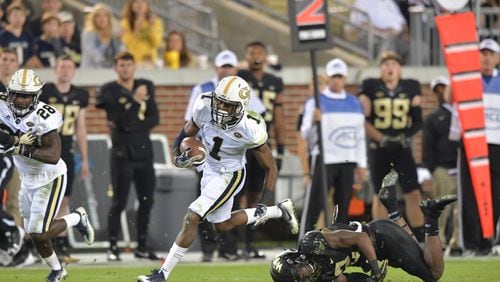Though the 2017 season is well past, Georgia Tech quarterback TaQuon Marshall has hardly forgotten it. For instance, he specifically can recall two games when the opposing defenses played the option in such a way that Marshall’s read was to pitch the ball to the A-backs.
Those two games were Miami and Georgia. The numbers would reflect their defense’s tactics. Against Miami, Tech A-backs Clinton Lynch, Qua Searcy, Nathan Cottrell and J.J. Green ran the ball a combined 21 times for 151 yards and a touchdown. Against the Bulldogs, the A-backs ran 16 times for a more muted 71 yards.
“A lot of teams, the way they played the option is they wanted me to keep the ball,” Marshall said at last week’s ACC Kickoff in Charlotte, N.C.
In the other nine games, A-backs had 81 carries for 631 yards. That’s a per-game average of nine attempts for 70.1 yards.
In the run game, A-back opportunities were thinner than any season in Johnson’s 10-season tenure. A-backs ran the ball 118 times last season, accounting for 18.7 percent of all carries. It was the lowest percentage for A-back carries in Johnson’s time at Tech. The percentage has typically been in the mid-20’s.
As Marshall noted, it was a reflection of defensive priorities. Johnson’s spread-option offense, now in its fourth decade, works in part because it can adjust to the defense. When opponents sought to limit the big-play threat posed by Lynch and Searcy, Tech could attack with Benson and Marshall.
“I think just from an experience standpoint, TaQuon was a little bit of an unknown, so people weren’t as apt to take him out of the game and make those (A-back) guys an option as it was the year before with (Justin Thomas),” Johnson said. “So in the flow of things, I don’t know that we’re going to do anything schematically different to get them the ball, I just think they’ll get more opportunities with the type of year that KirVonte and TaQuon had last year.”
RELATED:
7 key returning Tech players on offense
7 key returning Tech players on defense
It wasn’t only opponents who slanted the carries to Benson and Marshall. Tech’s strength up the middle (behind center Kenny Cooper, left guard Parker Braun and the right-guard tandem of Shamire Devine and Will Bryan) last season and the Yellow Jackets’ struggles with blocking on runs to the sideline called for the ball to be kept mainly with the quarterback and B-back.
Marshall carried the ball 247 times last season, 22.5 rushes per game. That was the highest average for a quarterback in Johnson’s tenure, surpassing Joshua Nesbitt in 2009 (19.9 carries per game). Marshall finished the season with 1,146 rushing yards, the most by a Tech quarterback in a single season.
Benson averaged 18.55 carries per game, which was also the highest rate for a player at that position in the Johnson era, barely edging out Anthony Allen in 2010 (18.46). (Benson benefited from being the clear No. 1, where other B-backs have split the position.) He finished with 1,053 yards, enough to earn second-team All-ACC honors.
“(Opponents) are going to try to keep me from getting as many yards as I did last year, and try to keep me from running the ball so much,” Marshall said. “So that opens it up for me to let the guys around me make plays. I’m going to get the ball in their hands and let them work and let those guys lead us down the field.”
An A-back with the ball on the edge can be a dangerous thing. Lynch, for example, worked off Thomas to great effect in their two seasons together. In 2014 and 2015, Lynch gained 872 yards on 85 carries. Of the 85 carries, 12 went for 20 or more yards and seven reached the end zone. Last season, hampered by a hamstring injury, Lynch gained 209 yards on 28 carries with no touchdowns.
Defenses will have a say in how much the A-backs get the ball on option plays. Tech can make it a more productive option with better blocking, both on the line and by the skill players. Lynch, Searcy and Cottrell are all home-run threats.
Their capabilities, and Benson and Marshall’s may muddle defensive priorities. Tech has returning starters at the three running back spots (Benson, Lynch and Searcy) and quarterback for just the second time in the Johnson era. Tech fans might be pleased to know the only other occurrence was 2009, when the Jackets won the ACC championship.
“I like to see those guys working,” Marshall said. “I like to see those guys make people miss and make big plays because I get excited when guys around me make big plays. Hopefully, this season, we’ll be able to get the ball in their hands a lot more and be able to see those guys run around a little bit.”







